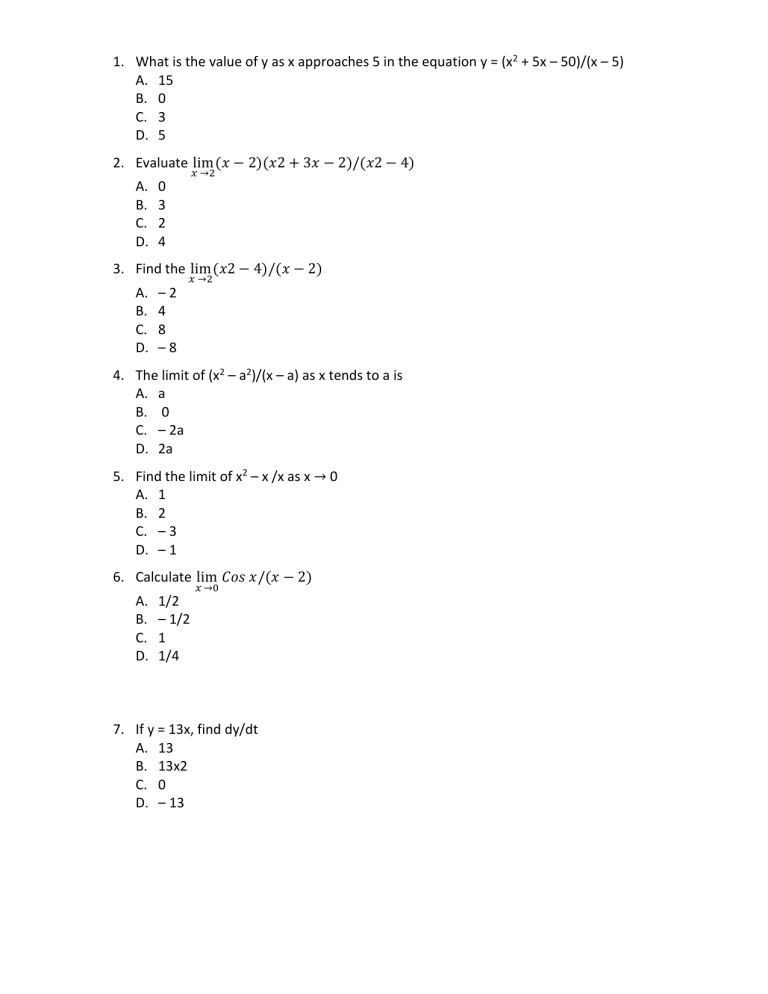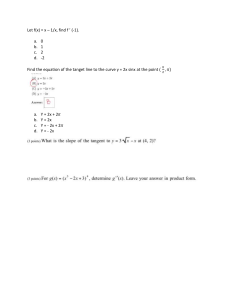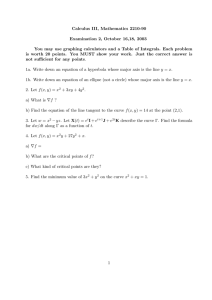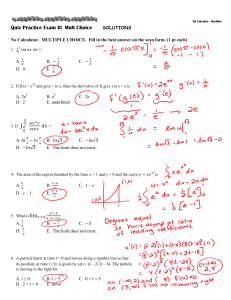
1. What is the value of y as x approaches 5 in the equation y = (x2 + 5x – 50)/(x – 5) A. 15 B. 0 C. 3 D. 5 2. Evaluate lim (𝑥 − 2)(𝑥2 + 3𝑥 − 2)/(𝑥2 − 4) 𝑥 →2 A. B. C. D. 0 3 2 4 3. Find the lim (𝑥2 − 4)/(𝑥 − 2) 𝑥 →2 A. B. C. D. –2 4 8 –8 4. The limit of (x2 – a2)/(x – a) as x tends to a is A. a B. 0 C. – 2a D. 2a 5. Find the limit of x2 – x /x as x → 0 A. 1 B. 2 C. – 3 D. – 1 6. Calculate lim 𝐶𝑜𝑠 𝑥/(𝑥 − 2) 𝑥 →0 A. B. C. D. 1/2 – 1/2 1 1/4 7. If y = 13x, find dy/dt A. 13 B. 13x2 C. 0 D. – 13 8. If y = 4x3 – 12x2 + 3x + 12, find dy/dx A. 12x2 – 24x + 3 B. 7x4 + 14x3 + 3x2 C. 12x4 – 24x3 + 3x2 D. 7x2 – 14x + 3 9. Find the derivative of f(x) = 2x(x2 + 3) A. 6(x2 + 1) B. 2(x2 + 3) C. 4x2 + 3 D. 6(x2 – 2) 10. Given that y = (x + 1)2, find dy/dx A. x + 1 B. 2(x + 1) C. x – 1 D. 2(x – 1) 11. If y = Sin 2x, find dy/dx A. – 2 Sin x B. – 2 Cos x C. 2 Cos 2x D. Cos 2x 12. Find the derivative of y = e2x + 3 with respect to x A. – 3e2x + 2 B. 2e2x + 3 C. – 2e2x + 2 D. 6e2x + 4 13. Find the derivative of y = Cos(3x2 – 2x) with respect to x A. – Sin(6x – 2) B. – Sin(3x2 – 2x) C. (6x – 2)Sin(3x2 – 2x) D. – (6x – 2)Sin(3x2 – 2x) 14. Find dy/dx if y = log 𝑒 (1/𝑥) A. – x B. – 1/x C. 1/x D. 1/x2 15. If y = 3 Cos(x/3), find dy/dx when x = 3𝜋/2 A. – 1 B. – 3 C. 2 D. 1 16. If y = x Sinx, find dy/dx when x = 𝜋/2 A. – 𝜋/2 B. – 1 C. 1 D. 𝜋/2 17. Differentiate x/Cosx with respect to x A. 1 + x Secx Tanx B. 1 + Sec2x C. Secx + x SecxTanx D. Cosx + x Tanx 18. Find the gradient of the curve y = 2 √𝑥 – 1/x at the point x = 1 A. 0 B. 1 C. 3 D. 2 19. The slope of the tangent to the curve y = 3x2 – 2x + 5 at the point (1, 6) is A. 6 B. 5 C. 1 D. 4 20. At what point is the gradient of the curve x2 – 6x + 3 equal to zero? A. 3 B. – 2 C. – 3 D. 2 21. At what value of x is the function x2 + x + 1 minimum? A. – 1 B. – 1/2 C. 1/2 D. 1 22. For what value of x will the function f(x) = x3 – 6x2 + 5 have turning point? A. 0, 2 B. 0, 4 C. 0, - 2 D. 0, - 4 23. Find the value of x for which the function f(x) = 2x3 – x2 – 4x + 4 has a maximum value A. – 2/3 B. 1 C. 2/3 D. – 1 24. Find the maximum value of the function y = 10 + 4x – x2 A. 10 B. 18 C. 14 D. 24 25. Find the maximum value of the function 2x3 + 3x2 – 72x + 1 A. 209 B. – 134 C. 298 D. 465 26. Find the turning points of the function y = 2x3 – 6x2 – 18x + 3 A. 0, 2 B. – 1, 2 C. 1, 3 D. – 1, 3 27. The turning point of the curve y = 5 – 2x – x2 occurs at A. – 2 B. – 1 C. 1 D. 2 28. If y = f(x) is an increasing function at a given interval, then A. dy/dx = 0 B. dy/dx < 0 C. dy/dx > 0 D. dy/dx < 1 29. At stationary point A. dy/dx = 0 B. dy/dx < 0 C. dy/dx > 0 D. dy/dx = 1 30. The motion of a particle along a straight line is described by the equation x = 4t4 – 3t3. Find the velocity after 3 seconds A. 273ms-1 B. 196ms-1 C. 482ms-1 D. 351ms-1 31. Using the question in number 30 above, find the acceleration after 3 seconds A. 422ms-2 B. 528ms-2 C. 378ms-2 D. 264ms-2 32. If 2x2 – 5y2 = 6xy, find dy/dx A. (3x + 5y)/(2x – 3y) B. (2x – 3y)/(3x + 5y) C. (2x + 3y)/(3x – 5y) D. 2x/(3x + 5y) 33. Differentiate with respect to x: y2 + x2 – 3xy = 4 A. (3y – 2x)/(2y – 3x) B. (2y + 3x)/3y – 2x) C. (2x – y)/(2y + 3x) D. 3x/(3x + 2y) 34. Find dy/dx if Cosx = Siny A. – Sinx/Cosy B. Cosx/Siny C. – 2Siny/Cosx D. 2Sinx/Cosx 35. Find the gradient of the curve y2x + 3x2y = 1 at the point (1, 1) A. 5/3 B. 9/8 C. – 7/5 D. – 3/4 36. The gradient of the curve x2 – 2xy – 2y2 – 2x = 0 at the point (1, - 4) is A. – 4/3 B. – 1/2 C. – 4/7 D. – 4/9 37. Resolve 2x + 11 into partial fractions (x – 2)(x + 3) A. 2x + 11 x–2 x+3 B. C. 3 1 x–2 x+3 11 + x–2 D. 3 x–2 1 x+3 + 1 x+3 10x + 1 ≡ (x – 2)(x + 1) A. 7 B. – 3 C. 3 D. 1 38. If 39. Resolve 1 r (r + 2) A. 1 + 2 r+2 2r B. 3 . Find the value of k x+1 into partial fractions 2 - 1 2r + 1 r+2 C. 1 r D. 1 2r + 1 2r – 1 - 1 2(r + 2) 40. Given that A. B. C. D. k + x–2 2x + 3 x2 – 5x + 6 ≡ K x–3 + R Find the value of K x–2 6 3 7 9 41. Using the question in 40 above, find the value of R A. 3 B. 7 C. 9 D. 6 42. Express 5 – 12x 6x2 + 5x + 1 A. 13 23 2x – 1 3x + 3 B. 27 3x + 1 - 22 2x + 1 C. 18 3x + 1 + 27 2x + 1 D. 17 + 2x + 1 23 3x + 1 in partial fractions 43. Given that 6x + M 2x + 7x – 15 2 A. B. C. D. 3+x (x – 1)(x – b) A. – 2 B. – 1/2 C. 2 D. 3 A. B. C. D. 4 x+5 x+3 express in partial fraction is x(x2 + 2) 3/2 – 3/2 –2 3 47. Find the value of C in question 45 above A. 3 B. – 2 C. 3 D. – 3/2 48. Express 3x + 5 in practical fractions (x + 2)2 + B x–2 A. A x+2 B. A - B x–2 (x + 2)2 D. 2 Find the constant M 2x – 3 express in partial fractions is 46. Find the value of B in question 45 above A. – 2 B. 3/2 C. – 3/2 D. 3 C. - 20 12 – 10 – 22 44. If 45. If ≡ A x - B (x – 2)2 A + (x + 2) B (x + 2)2 A + x 5 x–b - Bx + C x2 + 2 4 x–1 Find the value of b Find the value of A 49. If y = ln 𝑥 . Find dy/dx A. 1/x B. x2 C. 1/2x D. 1/x2 50. If y = 𝑒 𝑥 . Find dy/dx A. 2ex B. e-x C. ex D. e2x 1. Evaluate the limit of 3x3 + 2x2 + x + 1 as x tends to ∞ x3 + 2x + 5 b. Find dy/dx of the function 2x3 y2 – 3xy2 = 4 2. Find, from first principle, the derivative, with respect to x of the function y = 2x2 – x + 3 (b). Find the equation of the tangent to the curve x2y + y3x + 3x – 13 = 0 at the point (1, 2) 3. Differentiate the following with respect to x (i). 𝑒 𝑥 Cosx (ii). ln 𝑥 / 1 + Sinx (iii). ln 𝑠𝑖𝑛𝑥 (b). Find the range of values of x for which x3 – 5 x2 – 2x + 1 is decreasing 2 4. Resolve x3 + x2 + 4x x2 + x – 2 into partial fraction (b). The motion of a particle starting from O, is describe by the equation S = 2 t3 - 17 t2 + 21t where 3 2 S is the distance in meters, and t the time in seconds. Find the acceleration of the particle when it is momentarily at rest. 5. Find the turning points on the curve y = x4 + 5 x3 - 2x2 – 3x + 1 and distinguish between them. 2 3 2 (b). Sketch the curve of y = x - 9 3𝑥+1 1. A function is defined by F(x) = 𝑥 2 −1 . Find F|(2). 11 A. 9 B. -1 C. 4 D. 1 2. The distance s travelled by a car over a time interval, t is given by, s =3t 2 – 4t + 1. Find the speed of the car after 4 seconds. A. B. −5 m/s 6 −4 m/s 27 C. 20m/s D. 3 m/s √2 3. Find the gradient of the curve 5𝑥 2 = 4 + 3𝑦 2 at the point (-2,1) A. -4 −10 B. 3 C. ¼ D. 4 1 𝑑2 𝑦 4. Given that 𝑦 = 3𝑥 2 + 𝑥 2 , find 𝑑𝑥 2 . A. 6(1 + 𝑥14 ) 2 B. 6𝑥 − 𝑥 3 1 C. 6𝑥 2 + 2𝑥 D. 6𝑥 + 2𝑥 3 𝑑𝐴 5. Given that V = 4π𝑟 3 and A = 4π𝑟 2 , find 𝑑𝑉 A. B. C. D. 4 𝑟 4π𝑟 3 5 2𝑟 2 𝑟 6. Given that f(x) = 8x2+ 4ax. Find the value of a, such that f1(x) =20 at x=-1. A. 4 B. 8 C. 5 D. 9 7. At what value of x is the function y = x2 -2x – 3 minimum? A. 7 B. 6 C. 1 D.10 𝑑𝑦 8. If 𝑦 2 + 𝑦𝑥 − 𝑥 = 0, find 𝑑𝑥 1−𝑦 A. 2𝑦 B. 1−2𝑦 𝑥 1−𝑦 C. 𝑥+3𝑦 1−𝑦 D. 𝑥+2𝑦 9. Find what value of x for which f(x) = x3- 6x2 + 5 has turning point? A. −3 4 B. 0 or -4 C. -1 or 4 D. 0 or 4 10. A blacksmith produced x articles at a total cost of $(200-48x+3x2). If each article is sold at 3𝑥 $ 5 . Find the value of x for which the blacksmith makes a maximum profit. A. 10 B. 6 C. 8 D. 15 11. 𝐼𝑓 𝑓(𝑥) = 𝑚𝑥 2 − 6𝑥 − 3 𝑎𝑛𝑑 𝑓 ′ (1) = 12, 𝑓𝑖𝑛𝑑 𝑡ℎ𝑒 𝑣𝑎𝑙𝑢𝑒 𝑜𝑓 𝑐𝑜𝑛𝑠𝑡𝑎𝑛𝑡 𝑚. A. 9 B. 3 C. -3 D.-4 12. Find the derivative of 𝑦 = (3𝑥 2 + 5)4 with respect to x. A. 12(3𝑥 2 + 5)3 B. 24(3𝑥 2 + 5)3 C. 12𝑥(3𝑥 2 + 5)2 D. 24𝑥(3𝑥 2 + 5)5 𝑥 2 +4𝑥+3 13. Evaluate lim 2𝑥 2 +5𝑥−3 𝑥→3 A. -0.1 B. 0.8 C. 0.4 D. 1 1−𝑥 14. Evaluate lim 𝑥 2 +𝑥−2 𝑥→1 A. 1 B. ½ C. 0 D. −1 3 15. Given that 𝐴 = 𝑡 3 − 2𝑡 2 + 5𝑡 − 2, find the change in the value of A between t = 1 and t=3 A. 15 B. 6 C. 20 D. 19 16. Given 2𝑥+1 (𝑥−1)(𝑥+2) A. A=1, B=2 B. A=-1, B=2 C. A=1, B=-2 D. A=1, B=1 𝐴 𝐵 = 𝑥−1 + 𝑥+2, find the value of A and B. 2 17. If 𝑓(𝑥) = 3𝑥 2 + 𝑥 , 𝑓𝑖𝑛𝑑 𝑓 | (1). A. 6 B. −6 C. 4 D.−4 𝑑𝑦 18. Find the 𝑑𝑥 𝑖𝑓 9𝑥 2 + 25𝑦 2 = 225 A. B. 𝑥 𝑦 −9𝑥 25 C. x D. 𝑦 𝑐 𝑑𝑦 19. Given that the 𝑑𝑥 = 2 , when x=3. Find the value of a, If 𝑦 = 𝑥 2 + 𝑎𝑥 + 3. A. 4 B. 6 C. 7 D. -4 20. The velocity v of a car after time t is given by v = 2t2 +5t + 2. Find the acceleration after 6 seconds. A. 19m/s2 B. 7m/s2 C. 25m/s2 D. 29m/s2 21. Find the equation of the tangent to the curve x2 +3xy = 5 at the point (2,-1). A. -6y + x -11 = 0 B. 6y + x -12 = 0 C. 6y - x -11 = 0 D. 6y + 2x -11 = 0 𝑑2 𝑦 22. Find if y = 4x3- 5x2 - 5 𝑑𝑥 2 A. 24X +10 B. 24X – 10 C. 14X +10 D. 24X +5 𝑑𝑦 23. Given that 3x2 + 3y2 = 6, find 𝑑𝑥 at (10, 5). A. -1 B. 5 C. -2 D. 7 3 24. y = √𝑥 + √𝑥 5 , find the gradient of y. 7 A. B. 2√𝑥 1 2√𝑥 53 + 3 √𝑥 2 53 + 3 √𝑥 2 3 C.. √𝑥 2 D. 2 1 √ 73 + 3 √𝑥 2 𝑥 25. The area of the circular base of a cone is given by A = πr2, Find the derivative of A with respect to A, when r = 14cm. A. 48𝜋cm2 B. 18𝜋cm2 C. 28𝜋cm2 D. 28𝜋cm2 26. The distance, S, travelled by a racing car over a period t seconds, is given by s = 4t2+2. Find the speed of the car in the 4th seconds. A. 33m|s B. 25m|s C.10m|s D. 13m|s t3- 1 lim ( 𝑥) 27. Find 𝑥−−→∞ A. 0 B. 1 C. -1 D. 8 28. Given that y = 𝑒 𝑥 sinx, find A. B. C. D. 𝑥 3𝑒 sinx 𝑒 𝑥 (cosx + sinx) 𝑒 𝑥 𝑐𝑜𝑠x 𝑒 𝑥 sinx 𝑑𝑦 𝑑𝑥 . 29. The gradient of a line (4ax + 2) is -2. Find a. A. ¾ B. ½ C. – ½ D. 1 𝑑𝑃 30. P = Log (x-5), find 𝑑𝑥 1 A. 𝑥−5 2 B. 4−𝑥 5 C. 𝑥−1 −5 D. 𝑥−1 31. Find the coordinate of the points on the curve y = x3 – 3x2- 9x + 6 where the gradient is 0. A. (3,-21)(-1,11) B. (3,21)(1,11) C. (3,-1)(-1,1) D. (5,-2)(1,4) 𝑑𝑠 32. The total surface area of cylinder is given by S = 2𝜋𝑟 2 + 2𝜋𝑟ℎ, find 𝑑𝑟 A. 4𝜋𝑟 + 2𝜋ℎ B. 4𝜋𝑟 + 𝜋ℎ C. 3𝜋𝑟 + 2𝜋ℎ D. 4𝜋𝑟 + 3𝜋ℎ 33. Find the x-coordinate of the point on the curve y = 2x3+ x2- 2x + 1 where the curve is parallel to the line y = 2x. 2 A. 3 or -1 B. 2 3 or 1 2 C. - 3 or -1 2 D. 3 or 2 34. What the nature of the stationary point of y = 1 – 2x -2x2 have and what is the value of y at that point?. A. minimum (- ½ ,1½ ) B. maximum (- ½ ,1½ ) C. minimum (½ , 1½ ) D. maximum (- ½ , -1½ ) 35. Let s be the distance covered in time t. Which of the following equation is true of the acceleration of a moving object? A. a = 𝑑2 𝑠 𝑑𝑡 𝑑2 𝑠 B. a = 𝑑𝑡 2 𝑑2 𝑡 C. a = 𝑑𝑠2 𝑑2 𝑡 D. a = 𝑑𝑠2 36. If 10𝑥+1 (𝑥−2)(𝑥+1) 𝐾 = 𝑥−2 + 3 , then K has the vaule? 𝑥+1 A. 4 B. 8 C. 7 D. 2 37.Which of the forms below is true of the fraction 𝐴 𝐵 𝐴 (𝑥+2)2 𝐵 𝐴 (𝑥−2)2 𝐵 𝐴 (𝑥+2)2 𝐵 A. 𝑥− 2 + B. 𝑥 + 2 + C. 𝑥 + 2 + D. 𝑥− 2 + (𝑥−1)2 5−12𝑥 38. Resolve into6𝑥 2 +5𝑥+1 its component form. 27 22 25 2𝑥+1 22 27 2𝑥+1 20 27 2𝑥+1 12 A. 3𝑥+1 − B. 3𝑥+1 + C. 3𝑥+1 + D. 3𝑥+1 − 2𝑥+1 39. Resolving 1 A. 2𝑟 1 1 𝑟(𝑟+2) 1 3(𝑟+2) 1 B. 2𝑟 -5(𝑟+2) 1 1 1 1 C. 2𝑟 -7(𝑟+2) D. 2𝑟 -2(𝑟+2) into partial fractionbgives? 2𝑥 2 −𝑥+2 (𝑥+2)2 40. The radius of a circle is increasing at the rate of 0.4cms-1. Find the rate of increase in cm2s-1 of the area when the radius is 5cm. A. 2𝜋 B. 5𝜋 C. 12𝜋 D. 4𝜋 𝑥2 𝑑𝑦 1. (a) A curve has the equation y = 𝑥 +1 . Find 𝑑𝑥 where x = 2 (b) Find the coordinate of the stationary point of the curve (c) Find the equation of the tangent to the curve at the point x = - 2 2. (a) A cuboid has a total surface area of 120cm2. Their base measure x cm by 2x cm and its height is h cm. Show that the height h in terms of x is, h = (b) Show that the volume of the cuboid is V = 40x (c) Show that V has a stationary value when h = 60−2𝑥 2 3𝑥 4𝑥 3 3 4𝑥 3 3. (a) A function is given by f(x) = 5x2 – 3x + 7. Find the derivative of f(x) using first principle. (b) Sketch the curve y = (x – 1)(x – 2)(x + 3) 3𝑥+5 (c) A function g(x) = 2𝑥−3. Find the domain and range of g -1(x) 4. (a) Resolve into partial fraction (b) Given the rational function 2−4𝑥 𝑥(𝑥 2 −𝑥−2) 2√2− √5 3√2+2√5 = 𝑝 + 𝑞√10 where p and q are constants. Find the value of p – q. (c) A particle travels in a straight line so that, t seconds after passing through a fixed 𝑡 point O, its speed v m/s, is given by v = 8cos(2). Find the acceleration of the particle when t = 1 seconds.







